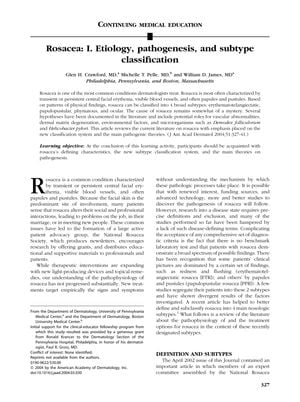Rosacea: Etiology, Pathogenesis, And Subtype Classification
August 2004
in “
Journal of the American Academy of Dermatology
”

TLDR Rosacea is a skin condition with unclear causes, classified into four subtypes.
Rosacea, a common dermatological condition, was characterized by central facial erythema, visible blood vessels, and often papules and pustules. It was classified into 4 subtypes: erythematotelangiectatic, papulopustular, phymatous, and ocular. The exact cause remained unclear, with hypotheses suggesting roles for vascular abnormalities, dermal matrix degeneration, environmental factors, and microorganisms like Demodex folliculorum and Helicobacter pylori. The article reviewed literature on rosacea, focusing on the new classification system and main pathogenic theories.
